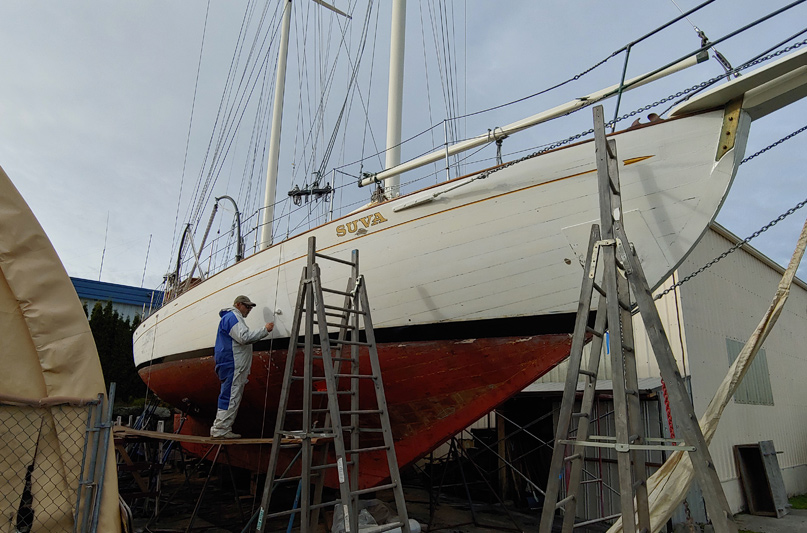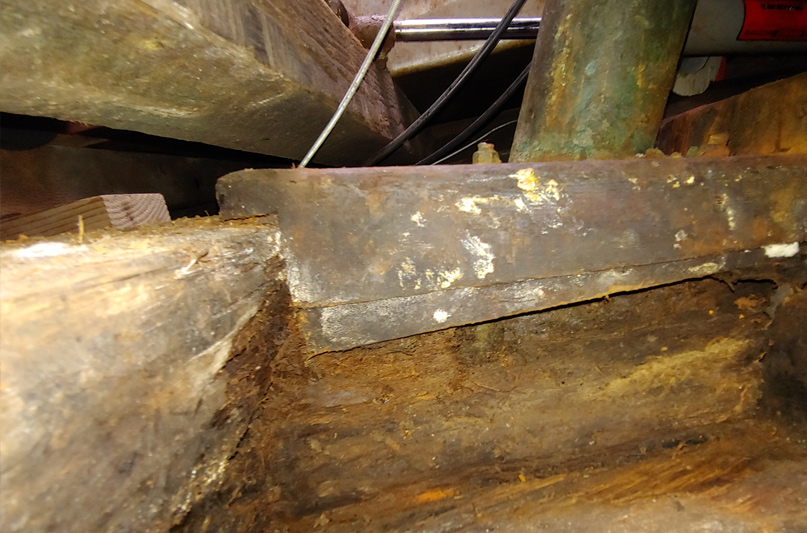
Most visitors to the idyllic Whidbey Island town of Coupeville will notice a wooden tallship docked at the century-old wharf in Penn Cove. The historic vessel intended to call Coupeville homeport, but now the ship is in jeopardy. The Suva, a 68’ staysail rigged schooner, was built for a Coupeville resident nearly 100 years ago, and after switching owners a few times and touring much of Puget Sound, returned to her original home a few years ago. She was preparing for her first season as an educational ship with a routine haulout when it was determined that the ship’s horn timber was not strong enough and needed to be replaced before she was fit to sail again.
Now the Coupeville Maritime Heritage Foundation (CMHF), which owns the Suva, is hoping sailors and maritime history buffs will pitch in with donations and spread the word to get this classic schooner with strong ties to Whidbey Island and the Pacific Northwest back out on the water.
The Suva was commissioned by Frank Pratt Jr., a wealthy attorney and town figurehead who once owned most of the land overlooking Ebey’s Landing on the central part of Whidbey Island. The schooner was designed by Ted Geary, a key figure in Northwest boatbuilding history, who turned the Suva plans over to Quan Lee of Hong Kong, who built the Suva out of old-growth Burmese teak, some pieces possibly over 1,000 years old. The Suva was originally delivered via Victoria, B.C., and has been in local waters ever since.
Pratt sailed on her for 15 years before selling her to his longtime financial manager Dietrich Schmidt for one dollar. Pratt died that same year, but the Schmidt family cared for the Suva for many years before selling her to Bill Brandt of Olympia, who enjoyed sailing on her for about 25 years. The Suva was then briefly owned by Scott Flickinger, before being purchased by Lloyd Baldwin. That’s where she remained until a few years ago, when Mark Saia, a Coupeville resident, started hunting for a boat to replace his charter company’s 44’ Catalina Morgan sailboat. Saia worked as a charter captain on Penn Cove, introducing visitors to the charms of Whidbey Island and Puget Sound.
When it came time to find a replacement for the Catalina, he knew he wanted a classic wood boat that would reflect Coupeville’s maritime pedigree as a town that was founded by sea captains in the 1850’s, while adding old-world charm to the Coupeville Wharf.
Saia came across the Suva online, and after hearing about her history and connection with Whidbey Island and Coupeville, knew she was the boat he was looking for. “The first time I saw the pilothouse it reminded me of my grandfather’s boat, who was a fisherman in the San Francisco Bay,” said Saia. On a mission to bring Suva home, Saia gathered several local historians and sailors to form the CMHF, a not-for-profit organization dedicated to using the Suva to teach students and locals about the history of Whidbey Island and building a connection with the natural world. “Education was a goal right from the start,” said Saia. He and the CMHF gathered the funds to purchase Suva from Baldwin, who joined the board of the foundation, and brought Suva back to her original home.
For several years, the Suva was used for day charters where passengers spent their time onboard getting to know the waters around Whidbey, learning the basics of sailing terms, and learning about the connection between the Suva and Coupeville. During this time, the board of the CMHF worked to get her certified by the Coast Guard to charter larger groups of 25 passengers plus crew, with the goal of taking entire classes of school kids on extended educational cruises.

“We knew that Suva was the perfect boat for these kinds of programs,” said Saia. “The focus of the cruises would be partially the maritime history of the region, but Suva would also serve as a ‘science under sail’ program, with kids doing environmental experiments, plankton tows, things like that.”
Saia and the CMHF labored to get the Suva compliant, and had just earned a U.S. Coast Guard Certificate of Inspection for large groups of passengers when, during a recent haulout, it was determined that the horn timber was rotten and not structurally sound. On a wooden boat like the Suva, the horn timber connects the sternpost to the transom and is the central support for the stern of the boat. “A damaged horn timber means replacing a key structural part of the ship,” said Andy Stewart of Emerald Marine Carpentry, the boatyard working on the Suva. “We need to do this repair to keep the boat seaworthy and able to fulfil her mission.”
The Coupeville Maritime Heritage Foundation is hoping that those interested in seeing a classic schooner take to the water again will help by make a donation to the project and spread the word. The CHMF has received a $70,000 grant for restoration, but that will only cover about half the costs. They are seeking donations to help offset the costs, which can be made on the CHMF website, schoonersuva.org. Donations are tax deductible and will go directly to supporting students, local businesses, and furthering student education regarding maritime history and science.
“People interested in getting Suva repaired and back in the water can contact Emerald Marine with questions or to come and take a look. Just be sure to get in touch first so we can accommodate you,” said Stewart.
Saia feels that the Suva is more than just another boat for the residents of Whidbey Island. “Suva is a connection to the maritime tradition of Whidbey Island, a tradition that’s being forgotten slowly.”
In the same way that many see the Lady Washington as a ship that belongs to the people of Washington state, Saia feels that the Suva belongs to the people of Whidbey Island. Do you want to learn more about the Suva and how to help? Reach out to info@schoonersuva.org and Emerald Marine at emeraldmarine@earthlink.net.